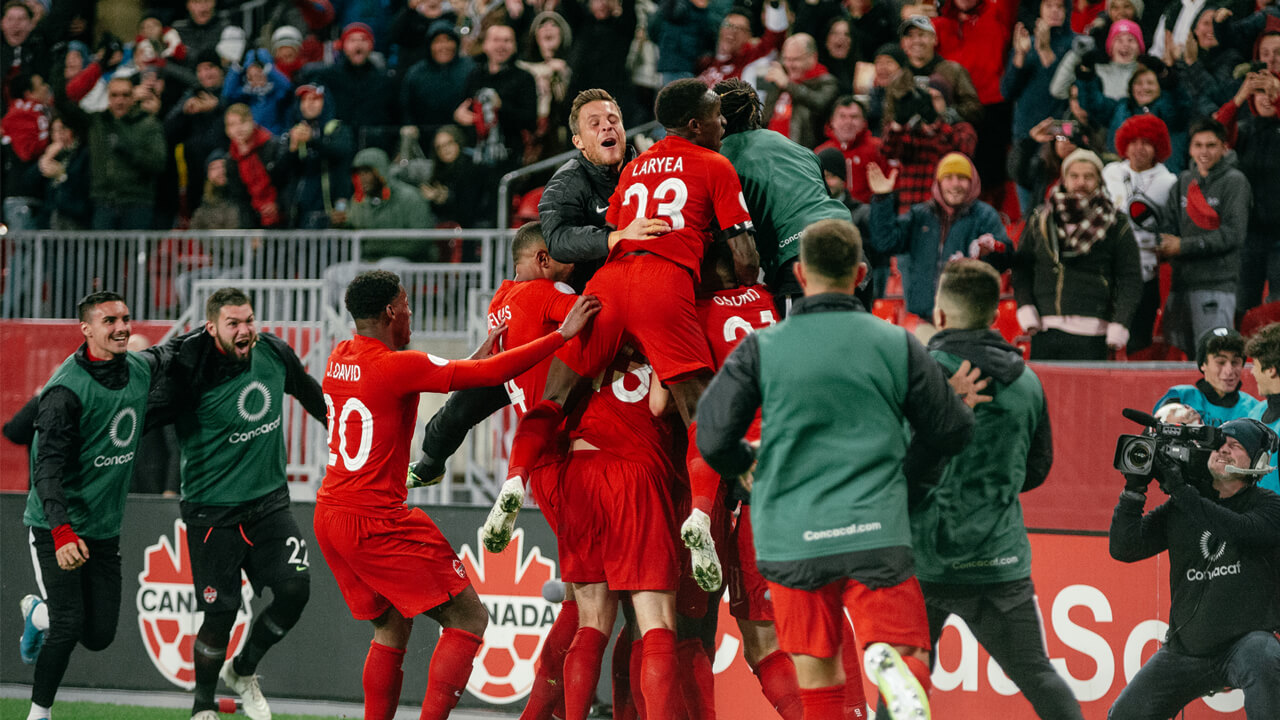
LOOK OUT, WORLD
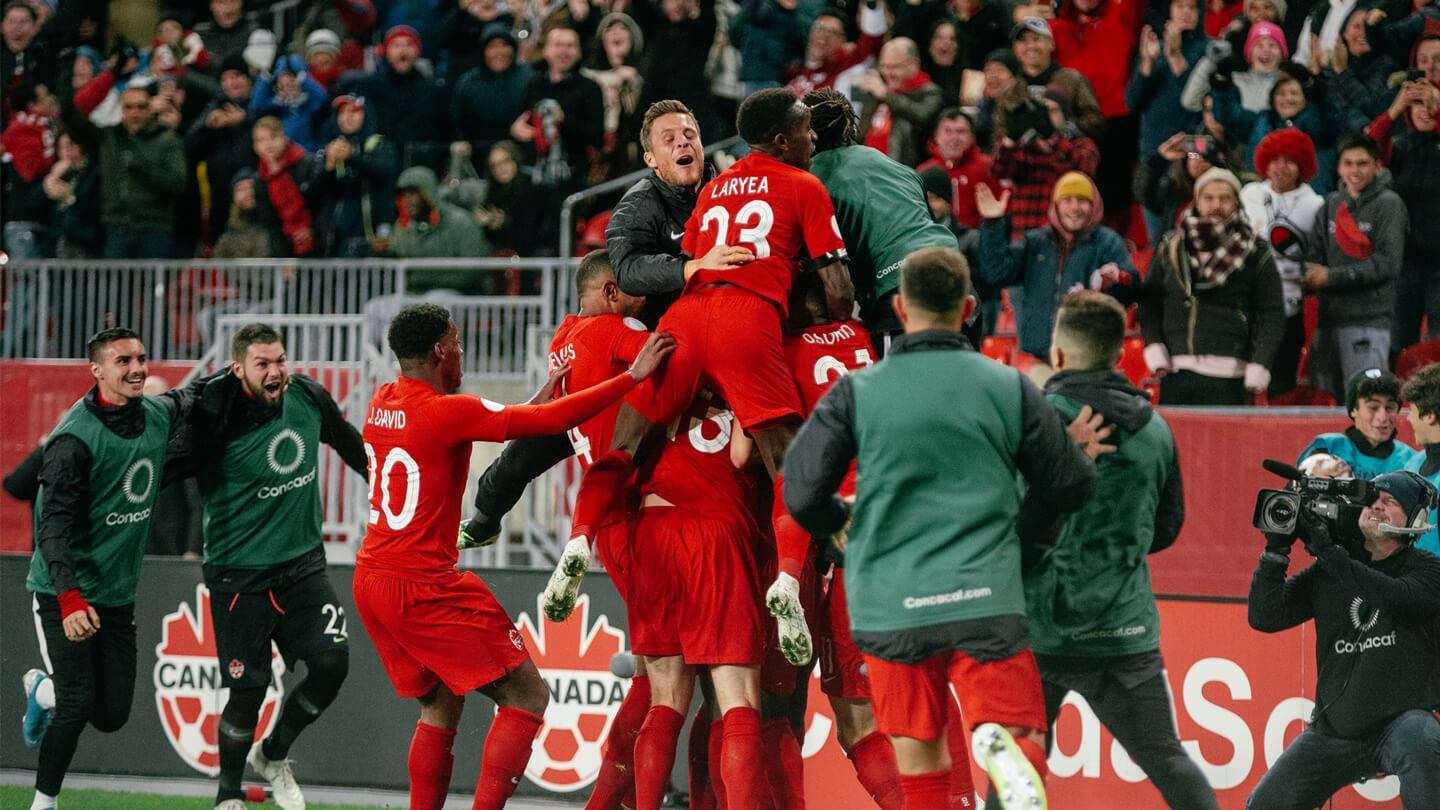
A
listair Johnston admits he was a bit perplexed by what was happening on the pitch. It was Oct. 13 and a Canadian team that was beginning to raise eyebrows during the early stages of Concacaf World Cup Qualifying was hosting Panama in a game knotted 1-1. In the 65th minute, Alphonso Davies — the avatar for soccer success in this nation — sprang into action, though it wasn’t immediately clear what the Bayern Munich stud had in mind. “It was late in the game, legs were heavy, and Phonzie just starts sprinting and I’m like, ‘Okay, I’m not sure what he’s got going on there,” says Johnston, a Team Canada fullback. “He somehow picks this guy’s pocket with some of the most unbelievably athletic, coordinated, balanced moves to keep that ball in play. At that point, I just stopped. You’re in awe that just happened. As you saw him sprinting [back to the Canadian end]in the very beginning, there was kind of a quiet hush. But as he got closer and closer, there were murmurs and all of a sudden the crowd is standing, he steals it and it’s a roar.”
By the time Davies whizzed past Panamanian defender Harold Cummings at BMO Field in Toronto, caressing the ball deftly with a backfoot touch to keep it from rolling out of bounds, what happened next felt inevitable. And as statement goals go, it was so absurdly amazing it nearly pushed into the realm of parody. Here was the best player — an already-arrived international star — on a frisky-but-unproven team about to deliver the go-ahead strike on grounds as hallowed as it gets in a country that isn’t exactly briming with soccer cathedrals. This was ‘Phonzie’ setting not just ‘The Six’ but the whole of Canada on fire while sending a message clear as day: If you give this aggressive Canadian squad even a crack, it’s capable of firing an arrow through the heart. As it unfolded, Johnston was just as spellbound as anyone else watching. “If you look at me, I am frozen solid,” he says. “As soon as he got into that moment, the crowd’s roar, you just knew, he’s going to finish this. He cuts inside and scores and the place just went berserk.”
That goal gave Canada a 2-1 win to close a three-game qualifying window. Since then, Canada has won five consecutive Concacaf games to surge to the top of the table ahead of traditional powers Mexico and the United States. If Davies finishing his run was a fait accompli, the same can now be said of Canada — which starts its final three-game qualifying stretch in Costa Rica tonight — earning a berth in the 2022 World Cup in Qatar. The top three teams in Concacaf make the tournament. Even if Canada is passed by the No. 2-ranked United States and third-place Mexico, it is still in. And even if, by some miracle, fourth-place Panama can pull ahead, too, despite trailing the table-leaders by eight points, Canada could still wind up in a crossover game with another federation to get to the big show. Really, all that’s left is to make it official and end a World Cup drought that dates back to 1986.
As fans — both new and long-suffering — prepare to party, it’s easy to be left wondering how a team nobody was talking about as recently as last summer is suddenly at the centre of mainstream sports conversations in Canada. Start poking around with that query and you’ll find, integral as Davies is, this is about more than one mega-star. There’s a perfect-storm element to what’s gone on here, a number of factors coalescing to form what has at times looked like nothing short of an unstoppable soccer wagon. Canada’s men aren’t creeping onto the world scene; they’re putting a boot through the front door. And the sense you get from those on the team and those around it is, ‘Now that we’re finally invited to the world football party, we plan on making ourselves at home.’
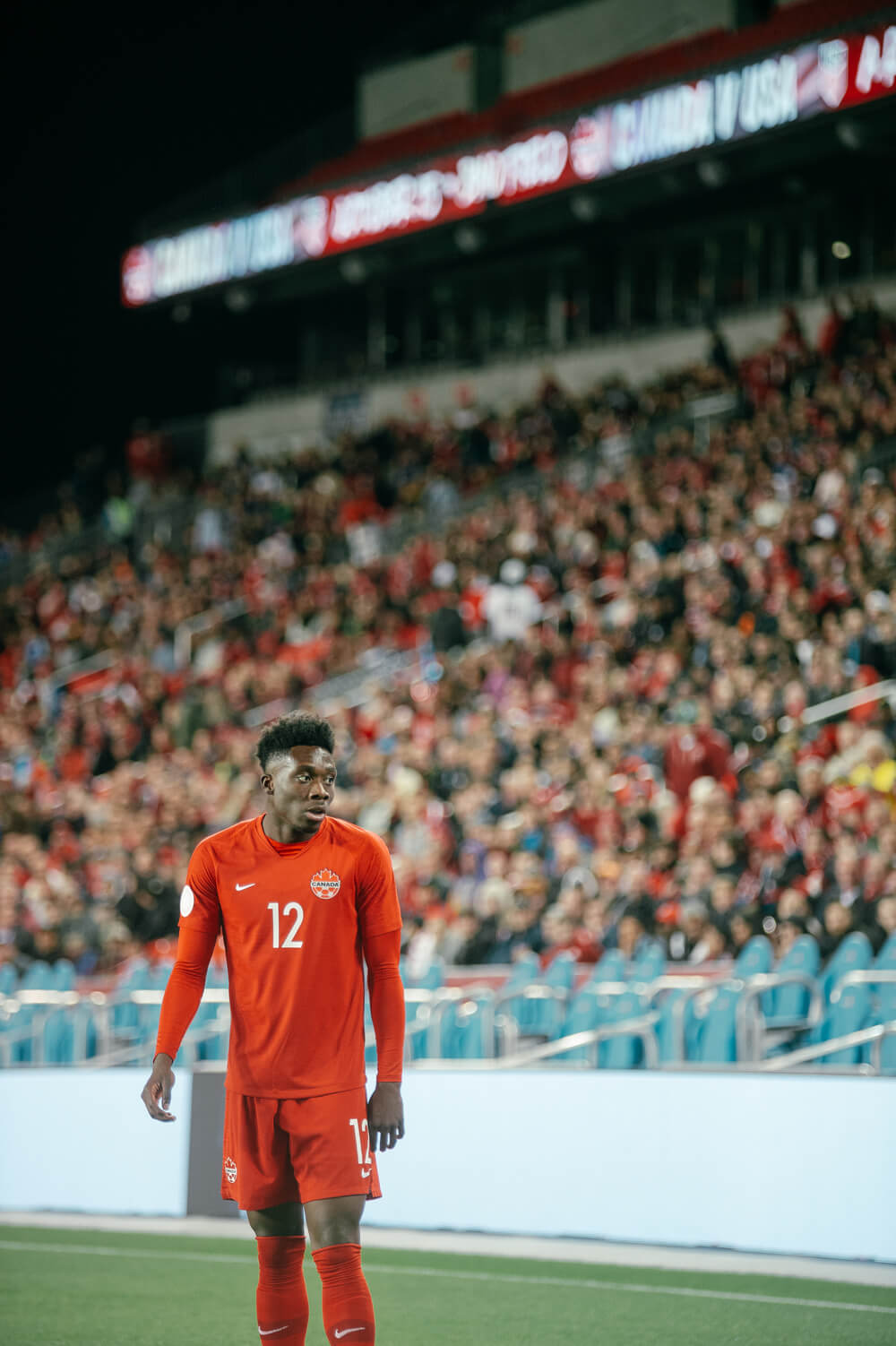
O
ne month after Davies’ strike against Panama electrified the country, fans in Northern Alberta prepared for another crucial two-game set at Edmonton’s Commonwealth Stadium as Canada looked to further legitimize its strong showing through the autumn. A Friday night meeting with Costa Rica meant everyone — many with soccer jerseys and a few with red-and-white hockey sweaters pulled over winter coats and snow pants — bounced into the stadium with hope and excitement bubbling over. The public address announcer may have even been the victim of some nerves as he accidentally introduced the hometown hero, Davies, twice while calling out the starting 11. Before the game began, Davies bolted over to the section where the Voyageurs — a travelling pack of rabid Canadian soccer supporters who first came together in Edmonton in the mid-’90s — were whooping it up and leapt into the air, stoking their already raging enthusiasm in unmistakable “Let’s goooo!” fashion. In the 14th minute, Davies cut through the box and took a marvelous feed from Liam Millar, only to see his shot attempt blocked by a bit of desperation defending. On the ensuing corner, a header cracked off the bar. It was still a 0-0 game when, in the opening minutes of the second half, Tajon Buchanan unleashed a bicycle kick that might have broken #CANMNT Twitter if it went in. Instead, it also rang the bar. All this meant that when, just moments later, Jonathan David did provide Canada the lead it had been sniffing, the goal — and, eventually, the 1-0 win — felt somewhat inevitable.
Sensing victory versus Costa Rica is one thing, but when Mexico came to town four days later — regardless of the roll Canada was on, the Prairie cold or the fact this edition of the Mexican team probably has one cleat on the other side of the mountain — it was still hard to imagine the home squad as favourites. But in the 50th minute, there was Cyle Larin charging to the net, leaping into the air and converting the free kick from Stephen Eustaquio for his second goal of a half that wasn’t yet six minutes old. As Larin rushed to the sideline in a swirl of black Canadian kits, Sam Adekugbe — who grew up three hours down the road in Calgary — came flying through the frame, performing a Commonwealth Cannonball into a pile of cleared snow. “That [captures]how I view this Canada team,” Grant Wahl, a longtime soccer journalist and host of the podcast Fútbol with Grant Wahl, says of the sequence. “They’re fun, they’re good and they’re enjoying it.”
To be sure, part of why the Canadians carry themselves with a certain swagger is because they have guys like Davies and David — top-tier talents who’ve proven themselves in the biggest clubs in Europe. Move down the roster, though, and you’ll find a lot of quality footballers who’ve likely gained self-assurance from being able to play a very high level of soccer at home in North America for some time now. It’s been 15 years since Major League Soccer arrived in Canada, bringing with it Toronto FC, the Vancouver Whitecaps and CF Montreal. Once upon a time, many hopefuls had to find places to play in lower-rung European leagues and pray they’d get noticed in a foreign land despite coming from a nation seen over there as a football backwater. That calculous has changed with the growth of a quality circuit right in their own backyard. And for every chosen-one talent like Davies, who played for Vancouver before moving to Bayern, there are 10 very good athletes — like midfielders Richie Laryea, now bound for England after six MLS campaigns, and Samuel Piette — who’ve turned into the best version of themselves on MLS fields and really helped raise the floor of the national team. Though roster limits on non-Americans for U.S.-based teams still make it harder for Canadians to carve out a spot on the loop, there’s no denying MLS has broadened options and provided an important proving ground for Canadian talent.
“2007 was, in some ways, a tipping point for the game in this country when TFC arrived and then Montreal and Vancouver soon after,” says James Sharman, who’s covered soccer for decades in this country and co-hosts Footy Prime The Podcast. “The whole professionalization of Canadian football began. Academies were held more accountable [and]they became more professional, [existing soccer]clubs were held more accountable. TFC and Vancouver and Montreal had their academies and showed the rest, ‘This is how you do it. We’re going to have our tentacles around the country find the best players, you better have the same if you want to compete.’”
Johnston is another of those players who plies his trade in MLS, having spent two seasons with Nashville before an off-season swap sent him to Montreal for the 2022 campaign. The 23-year-old says the trickle-down effect of having high-level soccer in Canada probably impacted him once he was a teenager, but hadn’t yet really taken hold when he was a youngster growing up in Aurora, Ont. Johnston — who, along with his brothers, was also a serious hockey-playing kid — recalls the summer when he was about 12 and his Aurora Stingers soccer team suddenly had no players because the AAA hockey teams start asking players to commit year-round at that age. “My soccer team pretty much folded because everyone except two players chose hockey over soccer,” he says.
Johnston eventually found his way to Richmond Hill, just a 20-minute drive south, where soccer had a larger presence. He believes, though, that kids today, no matter where they live, are more likely to find licensed coaches who are continually upgrading their education about the game. “The first couple coaches I had in Aurora were hockey guys who loved [soccer]too, played some soccer growing up, but it wasn’t their end all be all — they didn’t live or die by the game,” he says. “Nowadays, it’s tough to find a coach like that on a high-level team. No longer can you just be a guy who went, ‘Oh yeah, I played high-school soccer, let me go coach this U-14 rep team. So I think that’s also been a huge factor [in the overall rise of the game].”
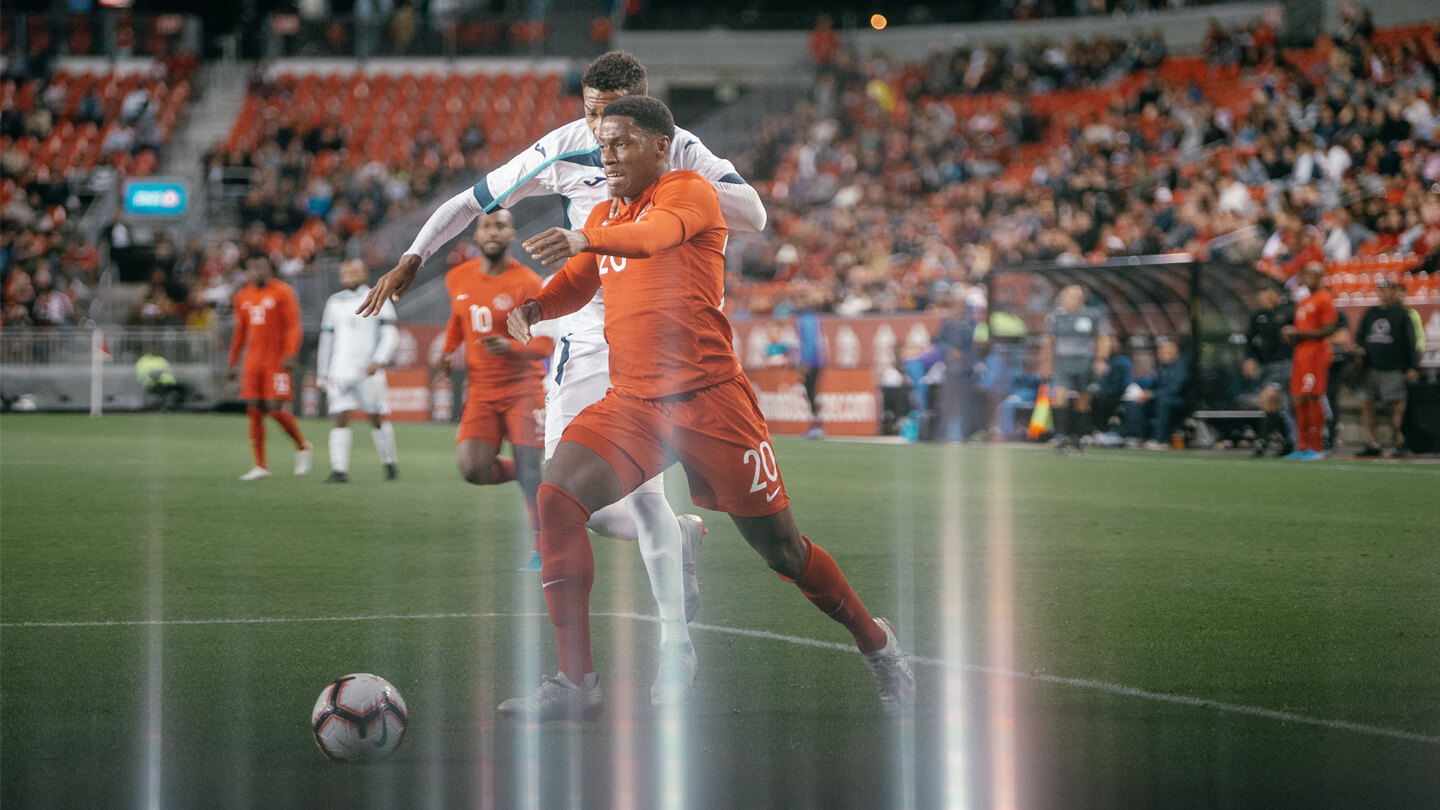
If the men and women on the sidelines at grassroots levels are making a positive impact, what is there to say about the suave Englishmen running the show at the top? Asked after the Jan. 30 win over United States what has changed in Canadian soccer, veteran goalie Milan Borjan was brief. “I can say just two words: John Herdman,” he said.
Borjan offered that succinct explanation with a Canadian flag draped over his shoulders. He’s been with the top team for nearly a decade and saw firsthand the fundamental shift that occurred when Herdman moved from coaching the Canadian women to the men’s side in 2018. It’s easy to forget, given how rosy things are now, that skepticism was everywhere when he was hired, with some pointing to the fact Herdman had never guided a men’s national side as a reason to undercut his credibility. But it’s fair to say the slight guy who grew up in pretty hardscrabble surroundings in Consett, in the northeast of England, has always relished proving people wrong. He wanted to be a player, but didn’t have the natural gifts. He was willing to do anything to stay in the game, so he took a job with Sunderland A.F.C., the hated rival of his beloved Newcastle United F.C. Then he moved to the other side of the world to run the women’s program in New Zealand. Canadians’ first up-close exposure to Herdman’s sideline intensity — and, Johnston notes, his “on-point” sneaker game — came when he took over the women’s national team in 2011. With Herdman setting the plan and force-of-nature forward Christine Sinclair leading the way on the field, Canada became international players, winning bronze medals at both the 2012 and ’16 Olympics. Now, Herdman is getting the most out of the men by — among other things — imbuing them with a self-belief that serves as the foundational building block for the achievements we’re witnessing now.
“His motivational speeches have everyone ready to run through any wall you put in front of them,” says Johnston. “He’s a master manipulator in that sense. He’s such a good man-manager that it doesn’t matter who I’m going up against. Right when I got to the [team in early 2021], we’re playing against Mexico or we’re playing the U.S., you’re going up against [American] Christian Pulisic, you’re going against [Mexican] ‘Chucky’ Lozano; but he has a way with words and instilling confidence in me that [makes me believe], ‘Yeah, you can go up against these guys; there’s no reason you don’t fit in here. You’re going to dominate this game.’
“If you really look at my background, I had played two years in the MLS — not even, actually, at that point — I came out of college soccer, I graduated [with]a degree in economics, why do I belong on the same pitch as them? But he never lets you get to that point.”
There’s a tendency to categorize coaches as either emotional leaders or great tacticians. In Herdman’s case, it’s truly a bit of both. He may have the lads ready to spit nails before a match, but he’s also relied on a certain versatility with this group that allows them to be as malleable as they are edgy. “We’re able to switch formations halfway through the game or 15 minutes into a game,” Johnston says. “Generally, club teams can’t even do that and they’ve had a whole pre-season and season to work on that.”
Getting people to do whatever is required for the team only occurs with complete buy-in. The brotherhood these players consistently reference now had to be cultivated. Midfielder Mark-Anthony Kaye actually recalls being a little dubious of the team-building exercises Herdman implemented in the beginning. He quickly came around, though, when he saw the sincerity in the coach’s actions and the impact it had on the team. “I just couldn’t see the value in it right away,” the 27-year-old Colorado Rapids midfielder says. “But now that I look back, I understand it, it gets you to put down your walls and trust the people around you and just be yourself. When people are allowed to be themselves, that’s when their best work comes out.”

I
n late January, with Davies sidelined by a COVID-related ailment, Canada opened its second-last World Cup qualifying with a 2-0 victory in Honduras. Then they came home to Hamilton for their second and final contest with a young American club that likely hasn’t yet reached its peak. All pretense about staying calm until this team actually clinches its World Cup spot was gone by then, at least on the spectator side of things. As the Canadian bus rolled in on Melrose Avenue, it was engulfed in plumes of red smoke and streamers of the same colour soared through the air. It was an explosion of joy worthy of anything you’d expect to see in Spain or Italy or anywhere else football is life. One woman captured the spirit of this squad with a sign that read, “Sorry, not Sorry.” COVID restrictions limited attendance, but if there really were only 12,000 people at Tim Hortons Field, then every single one of them found a way to sound like 10. When Larin slipped through the American defence, accepted a sweet feed from David and buried the opening goal in the sixth minute, laptops shook in the press box. It stayed 1-0 until the dying moments of the game, when Adekugbe suddenly found himself in alone and fired a shot from the top of the 18-yard box that American goalie Matt Turner didn’t even bother to move for. By that point, it wasn’t just enough for Canada to win, the team had to do it in emphatic, jaw-dropping fashion. When, a couple nights later, Canada took its third game of the window in El Salvador by the same 2-0 score, it basically turned these final three contests into a coronation.
“Literally, Canada’s men’s team is the best story globally in World Cup qualifying,” Wahl says.
Good-news soccer stories are not completely unheard of in this country, but it’s certainly been left to the women — coached to Olympic gold in 2022 by another Consett native, Bev Priestman — to pen them. Scarborough’s Paul Peschisolido is a former Canadian national team player who carved out a playing career in England in the 1990s and stayed in the game over there first as a manager, then as an agent. He’s thrilled to see this edition of the squad doing so well and carries fond memories from his time wearing red and white, even if looking back means shaking his head at the way things used to be. It’s not as though Canadian men’s soccer history is completely devoid of good players or outfits. The 1986 squad may have failed to score at the World Cup in Mexico, but pushed France extremely hard in the first game of the group stage, eventually losing 1-0 on a late Jean-Pierre Papin goal. In 2000, goalie Craig Forrest and forward Carlo Corazzin led Canada to its only Gold Cup. The likes of Julian de Guzman and Paul Stalteri also did this country proud. That said, Canadian players from back in the day will tell you the deck was always stacked against them in Concacaf because the people who ran the federation — including the likes of accused criminal Jack Warner — always angled to get the soccer-loving nations into the big games because they came with so much more baked-in interest. Questionable calls from referees and decisions to switch up qualifying procedures felt like the norm. And in those times, Peschisolido says the Canadian Soccer Association was unlikely to make much of a fuss, taking a stereotypically deferential Canadian posture instead. Really, it was a mom-and-pop association that depended on the loyalty of players who would do anything to play for their country. “Once we practised on a baseball diamond and across [the field]a guy was practising javelin, so we had to dodge the javelin while we’re training,” says Peschisolido. “This is international football and this is not that long ago.”
While things got incrementally better over the years, Herdman’s arrival really coincided with the expectation of utter professionalism across the board. If you want world-class players like Davies — still unavailable to the team for this final trio of matches — and David to bleed for you, you have to create an environment comparable to what they get playing for spare-nothing European clubs. That can be as basic as making easy travel plans for them to get here during qualifying windows; no more connecting through Amsterdam and Havana to save money, as was the case in Peschisolido’s day. When players are here, they need the same training equipment and dietary options they’re accustomed to. Suffice it to say, nobody is dodging flying javelins anymore.
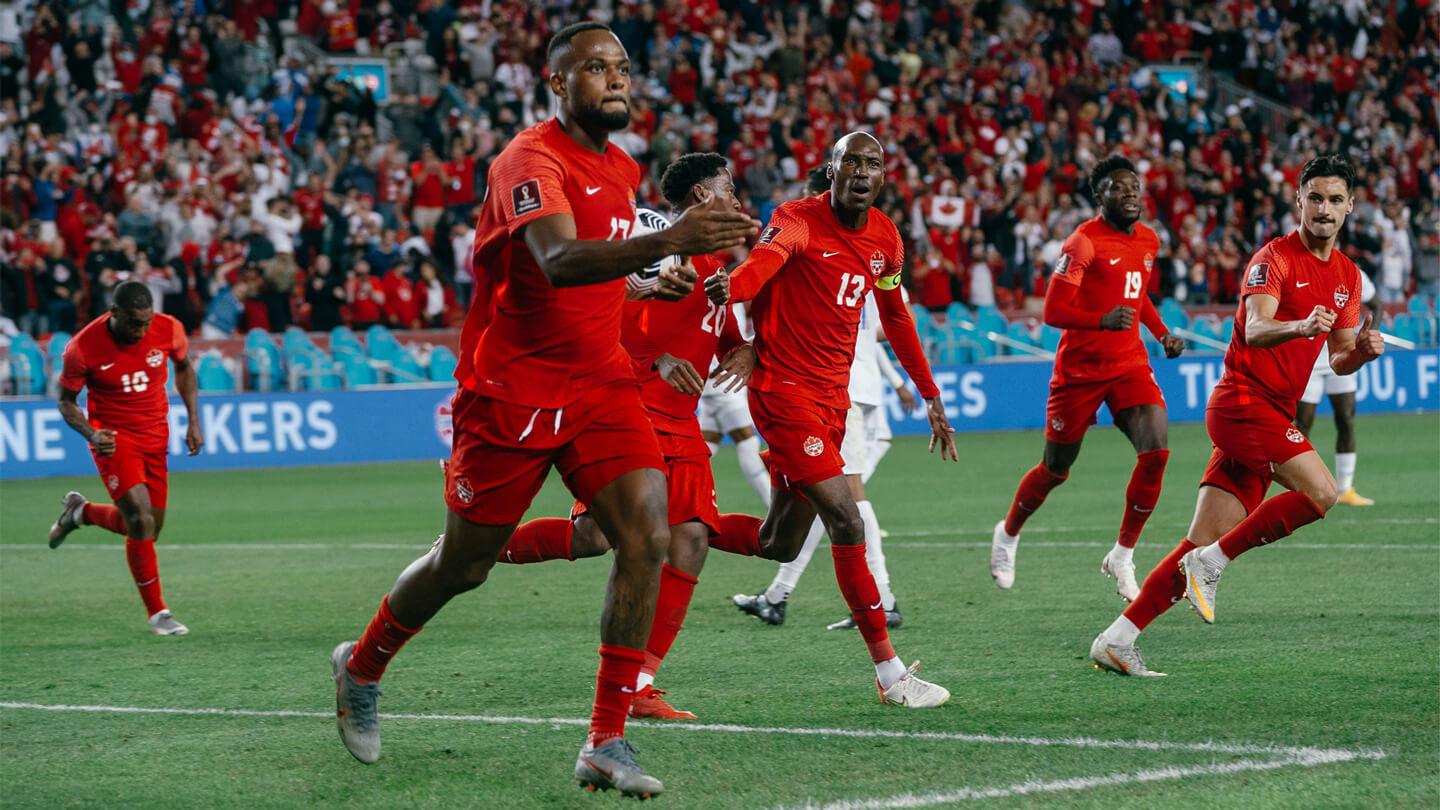
While things are quite comfortable for this generation of Canadian players now, that was not necessarily the case for many of them growing up. And if there’s a bonding element that pre-dates anything introduced by the coach, it’s the fact a number of them feel like they’ve been proving themselves from Day 1. Davies’ story of fleeing civil war in Liberia and winding up in Edmonton via a refugee camp in Ghana is well known. There’s nothing like that in Kaye’s background, but he was raised in Toronto alongside his brothers by a single mom in a situation where nothing came easily. “A lot of us grew up a certain way where we had to fight for everything,” Kaye says. “We weren’t given much. A lot of our players on the team are from Toronto and we all grew up very similar. Whether [we had]two parents or one parent, we didn’t grow up with a lot. So many guys have gone through that stuff. And you understand there are so many people in your country who go through the same thing. Soccer was our outlet and we just fought every day to continue to gain an edge on everyone else in the world. So now we’re at a world stage where we’re not going to give this up easily and if we have to fight to keep it, then we’re going to do that.”
Kaye says there’s no question he and his teammates are looking to make the path easier for the next generation. Johnston is convinced the composition of this team makes for a deeper connection with the country. “When people watch us, they can relate to us, they can see themselves in us,” he says. “And when you look at where everyone is from, it’s not [all]super-wealthy backgrounds, it’s kids from every [stripe]of life. I think that’s really cool. It looks like Canada out there.”
It also looks like this country is rapidly becoming a soccer nation, a status that should only be further cemented in coming years. The Canadian Premier League was established in 2017 and though the pandemic has certainly been a major curveball, the eight-team domestic circuit can surely become another avenue to funnel talent up. Some of the best men’s teams on the planet will perform on Canadian soil at the World Cup in 2026 and it’s widely expected Canada will gain automatic entry into the event as a co-host. By 2030, there could be as many as eight Concacaf teams invited to an expanding World Cup draw and it’s unthinkable Canada wouldn’t be one of them. World Cup allegiances in this land used to be driven by where your parents or grandparents were born. Johnston played in the backyard pretending to being an English national at the biggest sports event in the world. But hardcores are ready to sever old ties in favour of this easy-to-love Canadian team, while new fans who may know little about the game on a day-to-day basis are having no trouble understanding the magnitude of what’s happening. “There are no two more important words placed together in our sport than World Cup,” says Kristian Jack, an analyst on OneSoccer broadcasts. “It says everything. It just galvanizes everyone. It’s my [casual-fan friends] who don’t follow it who suddenly go, ‘I hear Canada is going to qualify for a World Cup?’ Everybody knows what a World Cup is, and that’s why the attention is on this team now.”
If it seems like there’s a searing spotlight on this club, how hot will it get come November if they start winning matches in Qatar? “They could potentially make noise,” Sharman says. “They’ve got game-breakers. Alphonso Davies, as we’ve seen, is a game-breaker. Jon David [is]a game-breaker. If they get to the World Cup and they get a decent draw, then why not?”
Confident as they are, the players are understandably not making any public declarations until they kick this thing over the line. To be sure, though, they are both touched and fuelled by the support they’ve received. After the victory over America in Hamilton, Johnston says people in Aurora just started leaving gifts on his parents’ doorstep. He’s got a ton of relatives in Vancouver who flew to Edmonton for the games there in November. They told him the plane ride over was packed with red jerseys worn by people singing ‘O Canada’ on an endless loop. Kaye has been floored by the outpouring, too. “I never knew that many people really cared about soccer in Canada,” he says. “It’s nice to be able to walk around and get recognition; it’s a good feeling and it makes you want to work even harder to get this country to a World Cup.”
For all intents and purposes, that goal has been realized. The only question left is, what’s next?
Tagwa Moyo/Sportsnet (5)




